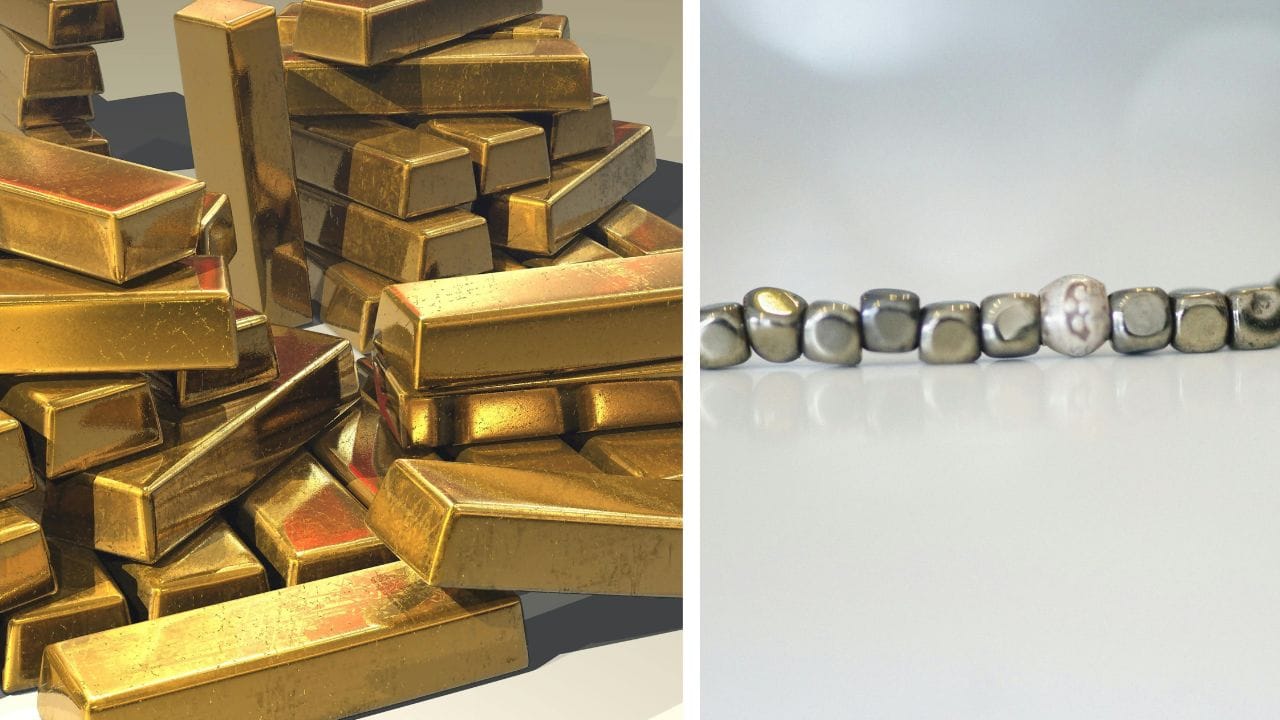Pyrite: The Glittering Deception Known as "Fool's Gold"
Pyrite is prized for its unique properties, being used in jewelry, decor, and scientific research for its conductivity.

Key Takeaways:
- Pyrite, often mistaken for gold, has a rich history and unique properties.
- The nickname "fool's gold" stems from its deceptive appearance.
- Pyrite bracelets are popular for their aesthetic and metaphysical benefits.
Introduction to Pyrite
Pyrite, a mineral with a metallic luster and pale brass-yellow hue, has fascinated humans for centuries. Its name derives from the Greek word "pyr," meaning fire, because it can create sparks when struck against steel. This mineral is composed of iron sulfide (FeS2) and is found in a variety of geological formations, from sedimentary deposits to hydrothermal veins.
Despite its resemblance to gold, pyrite is distinct in its chemical composition and physical properties. While gold is a precious metal, pyrite is a common sulfide mineral. This distinction is crucial for miners and geologists, who must differentiate between the two to avoid costly mistakes.
The Origins of the Name "Fool's Gold"
The term "fool's gold" emerged during the California Gold Rush in the mid-19th century. Prospectors, driven by dreams of wealth, often mistook pyrite for gold due to its similar appearance. The disappointment of realizing their "gold" was worthless led to the mineral's infamous nickname.
Pyrite's deceptive appearance has fooled many throughout history, not just during the Gold Rush. Even today, novice rock collectors and treasure hunters can be misled by its glittering facade. This enduring confusion underscores the importance of proper mineral identification techniques.
Physical Properties of Pyrite
Pyrite's metallic luster and pale brass-yellow color are its most distinguishing features. It often forms in cubic crystals, though it can also appear in other shapes, such as octahedrons and pyritohedrons. These geometric forms add to its visual appeal, making it a popular choice for jewelry and decorative items.
In addition to its appearance, pyrite is known for its hardness and brittleness. On the Mohs scale of mineral hardness, pyrite ranks at 6-6.5, making it harder than gold but more prone to breaking. This combination of properties makes pyrite both intriguing and challenging to work with.
Pyrite in History and Culture
Throughout history, pyrite has been used for various purposes, from tools to talismans. Ancient civilizations, such as the Greeks and Romans, utilized pyrite for its ability to produce sparks, using it to start fires. This practical application gave pyrite a place in early human technology.
In addition to its practical uses, pyrite has held symbolic significance in various cultures. Some believed it had protective properties, warding off negative energy and promoting physical well-being. This belief persists today, with pyrite bracelets and other jewelry items being popular for their supposed metaphysical benefits.
Pyrite vs. Gold: Key Differences
While pyrite and gold may look similar, they have several key differences. Gold is a precious metal with a distinct yellow color, while pyrite is a sulfide mineral with a brass-yellow hue. Gold is also much denser than pyrite, with a specific gravity of 19.3 compared to pyrite's 5.0.
Another critical difference is their reaction to acid. Gold is resistant to most acids, while pyrite reacts with hydrochloric acid, producing a sulfurous odor. These differences are essential for anyone working with minerals, from geologists to jewelers, to avoid costly mistakes.
The Role of Pyrite in Modern Science
In modern science, pyrite plays a significant role in various fields, from geology to materials science. Geologists study pyrite to understand the conditions under which it forms, providing insights into the Earth's geological history. Pyrite's presence can also indicate the potential for other valuable minerals, such as gold and copper.
Materials scientists are exploring pyrite's potential in new technologies, such as solar cells and batteries. Its abundance and unique properties make it an attractive candidate for sustainable energy solutions. These ongoing studies highlight pyrite's continued relevance in scientific research.
Pyrite in Jewelry and Fashion
Pyrite's striking appearance makes it a popular choice for jewelry and fashion accessories. Pyrite bracelets, necklaces, and earrings are sought after for their unique look and perceived metaphysical properties. The mineral's metallic luster and geometric shapes add a touch of elegance and intrigue to any outfit.
In addition to its aesthetic appeal, pyrite is believed to have various metaphysical benefits. Some people wear pyrite bracelets to attract wealth and abundance, while others use it for protection and grounding. These beliefs, though not scientifically proven, add to pyrite's allure in the world of fashion and jewelry.
The Metaphysical Properties of Pyrite
Many people believe that pyrite possesses metaphysical properties that can enhance one's life. It is often associated with wealth and prosperity, earning it the nickname "the stone of abundance." Some wear pyrite bracelets or keep pyrite stones in their homes to attract financial success and good fortune.
In addition to its association with wealth, pyrite is believed to have protective properties. It is thought to shield against negative energy and promote physical and emotional well-being. These beliefs make pyrite a popular choice for those seeking more than just a beautiful piece of jewelry.
How to Identify Pyrite
Identifying pyrite involves examining its physical properties and conducting simple tests. One of the easiest ways to distinguish pyrite from gold is by its hardness. Pyrite is harder than gold and can scratch glass, while gold is softer and malleable.
Another method is the streak test, which involves rubbing the mineral on a piece of unglazed porcelain. Pyrite leaves a black or dark green streak, while gold leaves a yellow streak. These tests, combined with visual inspection, can help accurately identify pyrite.
Pyrite in Nature
Pyrite is found in various geological environments, from sedimentary deposits to hydrothermal veins. It often occurs alongside other minerals, such as quartz and calcite, forming beautiful and intricate crystal clusters. These natural formations make pyrite a favorite among mineral collectors and enthusiasts.
In addition to its aesthetic appeal, pyrite's presence can indicate the potential for other valuable minerals. Geologists often study pyrite deposits to assess the likelihood of finding gold, copper, and other metals. This makes pyrite an essential mineral in the field of economic geology.
The Environmental Impact of Pyrite Mining
Mining pyrite can have significant environmental impacts, particularly when it comes to acid mine drainage. When pyrite is exposed to air and water, it can produce sulfuric acid, which can leach into nearby water sources. This process can harm aquatic life and contaminate drinking water supplies.
To mitigate these impacts, mining companies must implement proper waste management and water treatment practices. These measures can help minimize the environmental footprint of pyrite mining and protect surrounding ecosystems. Ongoing research aims to develop more sustainable mining techniques for pyrite and other minerals.
Pyrite in Art and Decoration
Pyrite's unique appearance makes it a popular choice for art and decoration. Artists and craftsmen use pyrite to create stunning sculptures, mosaics, and other decorative items. Its metallic luster and geometric shapes add a touch of elegance and sophistication to any piece.
In addition to its use in art, pyrite is often incorporated into home decor. Pyrite clusters and polished stones can be displayed as natural works of art, adding a touch of nature's beauty to any space. These decorative uses highlight pyrite's versatility and enduring appeal.
The Future of Pyrite
As scientific research continues to uncover new applications for pyrite, its future looks promising. From sustainable energy solutions to advanced materials, pyrite's unique properties make it an attractive candidate for various technological innovations. These developments could enhance pyrite's value and relevance in the coming years.
In addition to its scientific potential, pyrite's popularity in jewelry and fashion shows no signs of waning. Pyrite bracelets and other accessories will likely remain in demand for their aesthetic and metaphysical appeal. This enduring interest ensures that pyrite will continue to captivate and inspire for generations to come.
Pyrite in Popular Culture
Pyrite has made its mark in popular culture, appearing in literature, movies, and even video games. Its nickname, "fool's gold," has become synonymous with deception and false promises. This cultural significance adds another layer of intrigue to pyrite's story.
In addition to its symbolic meaning, pyrite's striking appearance has made it a favorite among artists and designers. Its metallic luster and geometric shapes have inspired countless works of art, from jewelry to sculptures. This cultural impact underscores pyrite's enduring appeal and fascination.
Collecting Pyrite
For mineral collectors, pyrite is a prized addition to any collection. Its unique crystal formations and metallic luster make it a standout specimen. Collectors often seek out pyrite from specific locations, such as Spain's Navajún mines, known for their exceptional cubic crystals.
In addition to its aesthetic appeal, pyrite's association with gold adds an element of historical and geological interest. Collectors value pyrite not only for its beauty but also for its significance in the history of mining and mineralogy. This makes pyrite a fascinating and valuable addition to any collection.
Pyrite in Education
Pyrite is an essential teaching tool in geology and mineralogy. Its distinctive properties make it an excellent example for demonstrating mineral identification techniques. Students learn to recognize pyrite's metallic luster, brass-yellow color, and crystal forms, honing their skills in mineral identification.
In addition to its use in teaching, pyrite is often included in educational kits and exhibits. Museums and science centers display pyrite specimens to educate the public about minerals and geology. These educational uses highlight pyrite's importance in fostering a deeper understanding of the natural world.
Pyrite and Technology
Pyrite's unique properties have caught the attention of researchers in the field of technology. Its potential applications in solar cells and batteries are particularly promising. Pyrite's abundance and cost-effectiveness make it an attractive alternative to more expensive materials.
Ongoing research aims to harness pyrite's properties for sustainable energy solutions. If successful, these innovations could revolutionize the way we generate and store energy. This potential underscores pyrite's relevance in the quest for cleaner and more efficient technologies.
Pyrite in Folklore and Mythology
Throughout history, pyrite has been the subject of various myths and legends. Some cultures believed that pyrite could protect against evil spirits and bring good fortune. These beliefs have contributed to pyrite's enduring allure and mystique.
In addition to its protective properties, pyrite was often associated with fire and transformation. Its ability to produce sparks when struck against steel made it a symbol of fire and energy. These symbolic meanings add another layer of depth to pyrite's rich history and cultural significance.
Pyrite in the Modern Market
Today, pyrite is a popular choice for jewelry, home decor, and collector's items. Pyrite bracelets, necklaces, and earrings are sought after for their unique look and perceived metaphysical benefits. The mineral's metallic luster and geometric shapes add a touch of elegance and intrigue to any outfit.
In addition to its use in fashion, pyrite is often incorporated into home decor. Pyrite clusters and polished stones can be displayed as natural works of art, adding a touch of nature's beauty to any space. These decorative uses highlight pyrite's versatility and enduring appeal.
Summary
Pyrite, often mistaken for gold, has a rich history and unique properties that continue to captivate and inspire. Its nickname, "fool's gold," stems from its deceptive appearance, which has fooled many throughout history.
Despite this, pyrite remains a popular choice for jewelry, home decor, and scientific research. Its unique properties and potential applications in technology make it a mineral of enduring interest and relevance. If you're looking for captivating and inspiring jewelry, click the button below to explore our handpicked selection of pyrite bracelets.

